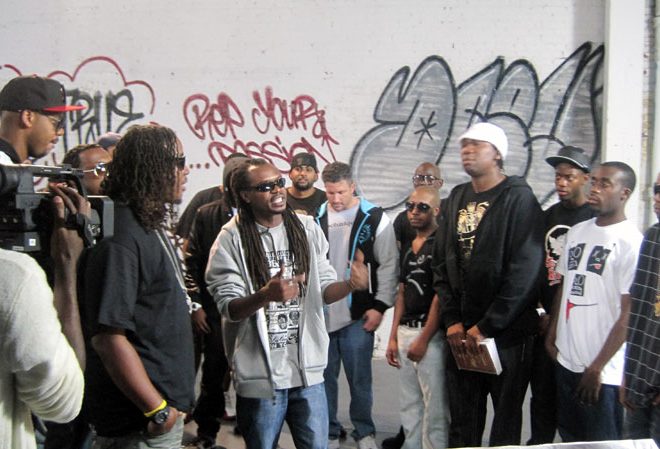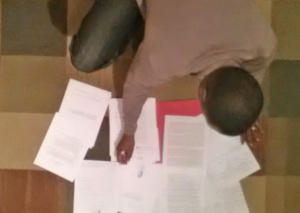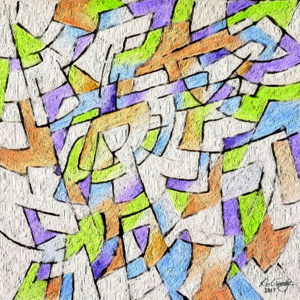What My Childhood Nightmares about Typography Taught Me
Letters and words have their own kind of power in real life…and even in our dreams.
“They’ve promised that dreams can come true – but forgot to mention that nightmares are dreams, too.” –Oscar Wilde
Dreams, real and imagined, are important in American culture. The American Dream continues to draw immigrants from around the world seeking a better life. Then, there is the entertainment industry selling carefully branded visions of our desires using text and images. Social media, aspirational to its core, provides cheesy affirmations and positivity ad infinitum. This should not be a surprise. Americans are an optimistic bunch always finding way to progress and innovate despite our present economic and political landscape. There is money to be made in exploiting this kind of optimistic outlook. It shows up in our literature and media content in the form of science fiction, dystopian and fantasy worlds, multiverses and alternative realities. It helps one escape the present and stoke the imagination. Disney knows this well. It has been creating these kind of fantasies for years. But keep in mind, someone else’s idea of fulfillment could be someone else’s existential prison. Activist Malcolm X articulated this sentiment well in his 1964 Ballot or the Bullet speech describing African American life under American racial terrorism and discrimination.
If we go further back into ancient history, the concept of dreams was mainly associated with divination, altered states and religious ceremonies. While modern humans turn to powerful image-making technologies, ancient people turned to their ancestors, shamans, mediums, priests, magicians, spirits and ummm…psychoactive drugs to interpret and actualize their dreams. (We use drugs, too…like that coffee you drink.)
Dream fascination and interpretation is a latent acknowledgement that there may be other realities besides our own. The alternative may even be sought after but, in reality, what are we really looking for? Make no mistake, this preoccupation should also raise questions about whether our desires are positive longings or negative inclinations.
Nightmares are Real
There was a recurring terror I experienced as a child This was not the typical nightmare of evil lurking in the dark. That happened when I ate too much ice cream before bed.
This was different.
I dreamed I was being frantically chased by…letters. I am not making this up!
Not a letter that one sends in the mail. I am talking about the letters in the English alphabet!
These letterforms (some black, some outlined and some colorful) were all bunched together (but not forming words) changing into random amorphous shapes, enlarging and shrinking at different moments, as they pursued me. Somehow in the dream, I knew to be afraid.
For years, I did not share this nightmare with anyone because I thought it would make me look crazy. I also assumed that maybe I was being influenced by my TV viewing. Many of the edutainment programs like Sesame Street and School House Rock were known for talking, walking and singing letters and words.
Whether one admits it or not, dreams can affect reality because some of them reveal one’s underlying fears and insecurities. For example, while riding the El train to and fro middle school in Philadelphia, I would occasionally see graffiti that reminded me of the letters in my nightmares. I find it interesting that these dreams stopped around the time I started experimenting with my own graffiti and letterforms in my notebook. Is this why Harvard University psychologist Deirdre Barrett theorizes that nightmares act as the brain’s way of focusing a person’s attention on issues that need to be addressed.? What did I need to confront?
 As a freshmen at The University of the Arts (UArts) in Philadelphia, I traveled to New York City with my classmates and professors on a class trip to visit art museums. Afterwards, I happily rode a subway train to the South Bronx just to observe the graffiti. During this time, crime in the city was very high as it declared war on graffiti artists. These invisible street artists were bombing (spraypainting) whole subway and elevated train cars with their unique handcrafted letterforms, sometimes cryptic messages and bold narratives making the Big Apple feel their presence.
As a freshmen at The University of the Arts (UArts) in Philadelphia, I traveled to New York City with my classmates and professors on a class trip to visit art museums. Afterwards, I happily rode a subway train to the South Bronx just to observe the graffiti. During this time, crime in the city was very high as it declared war on graffiti artists. These invisible street artists were bombing (spraypainting) whole subway and elevated train cars with their unique handcrafted letterforms, sometimes cryptic messages and bold narratives making the Big Apple feel their presence.
In my sophomore and junior years in the UArts graphic design department, I completed several required courses that helped extend my understanding of typography.
- A Letter Form Design course focused on the analysis and development of letterforms by hand.
- A Typography Systems course investigating typography using information hierarchies in a communication context.
Although these courses emphasized readability and simplicity, they also opened the door to pushing these exact boundaries believing that aesthetics could also be used in service to design solutions. Retired Basel professor Wolfgang Weingart is seen as the pioneer of this postmodern approach that influenced a whole generation of U.S. graphic design practitioners. He visited the UArts in the late 1980s to do a weeklong workshop that championed understanding the Swiss principles in typography…and breaking them. This started to confirm some of my initial thoughts that to create type, like fine art, is to create images with associated meanings. If images are socially constructed artifacts, then there is a context to be discovered.
Although graffiti was mixed with gang culture in the U.S., it began to move beyond just marking territory. The question is, what were some of the conditions that contributed to these street artists (mostly young, Black and Brown) risking their lives to create their work in the dead of night? Well, combine underdeveloped raw artistic talent with coming of age existential angst specific to western countries focused on progress, innovation and individualism. This creates a combustible mix. Democracies (some more than others) claim to provide room for re-imagination while authoritarian regimes limit this expression. Yet in the U.S,, Black and Brown people have always felt like their lives were restricted. The graf artists’ typography rejected this forced invisibility in public spaces. I believe it is true that the more invisible one feels, the more important communication and context become.
Now, contrast this with Weingart’s experience. Based on an aiga,org article at a young age, he was hired as a teacher at Basel School of Design in Switzerland. He was given space to publicly go against the school’s time honored typographic Swiss traditions and teach what he had learned to his students. If you look at some of Weingart’s posters, most of them do have a street art look: bold, dynamic, post modern and collaged where the type also becomes image…like graffiti. Now imagine if American educational institutions tried to understand graffiti’s context in the 1980s and were open to graf artists applying its foundational approach and ideas to art. (Truth be told, there were a few New York museums that saw this potential since both the late Keith Haring and Jean Michel Basquiat were graffiti artists early in their careers.) Anarchical energies are usually the domain of the young. But as someone who has spent a considerable amount of time around young people, I believe they simply need help to focus their energies without burning out. In the U.S., graf artists were simply branded as vandals.
As Zimbabwean graphic design educator Saki Mafundikwa said in his book, Afrikan Alphabets, without the written word, there would be no graphic design. I came to this same conclusion as a college student quietly maintaining my graffiti skills and embracing Weingart’s approach to letters and words. Did I do it well? Probably not. But I have learned that engaging in this kind of play come with its own kind of anthropological power. Isn’t this why authoritarian regimes like Fascist Italy, Nazi Germany and Communist Russia (and Trumpism?) placed a real emphasis on controlling text and images? Isn’t this also why democracies still champion the fourth estate? This is why W.E.B. DuBois’ quote weighs heavily on me:
“Thus all art is propaganda and ever must be, despite the wailing of the purists. I stand in utter shamelessness and say that whatever art I have for writing has been used always for propaganda for gaining the right of black folk to love and enjoy. I do not care a damn for any art that is not used for propaganda. But I do care when propaganda is confined to one side while the other is stripped and silent.”
Greek philosopher Plato believed that the concept of ‘play’ in some form could provide a stimulus to knowledge and skill development. He reasoned that this was why sports and music were very important in Greek culture. UArts Graphic design professor Ken Hiebert (now retired) often emphasized a similar idea in our senior graphic design thesis class as we experimented with image, type, composition and color. When viewed in a broader context, psychologists see the process of play among children as a form of socialization. When I briefly left the Graphic Design industry to become a youth mentor and teacher, I learned more about Black children and youth in my afterschool programs while observing them at play using art supplies, science projects and childhood games. For example, one of their assignments was to create their own language and letterforms. As they worked together, they had to examine their own relationship with written and oral communication as we studied different typefaces. I got in trouble with the elementary school when the students wrote notes to each other in class that the teacher could not decipher. But I have no regrets. This was good trouble.

Freestyle Cipher
The Power of Words
While briefly in seminary, I studied the three Abrahamic monotheistic religions: Judaism, Islam and Christianity. One narrative that they all share is in the book of Genesis. God speaks the universe into existence from nothing through a series of verbal commands. He ends each creative act with the same moral conviction pronouncing it was good. Although there is a very supernatural element in this story, the underlying truth is that our moral convictions (associated meanings) give our words and images anthropological power to alter how we and others see and respond to reality. If this is true, the graphic designer needs to wield this power to influence and persuade very carefully and humbly.
This power is referred to consistently throughout the Bible as it warns that we need to be careful what we speak into existence. (I am clear here that I am not saying that words are magic. I am simply implying that consistent coherent communication can influence.) As a Christian in my teens living in a distressed neighborhood, my local church taught me how Jesus Christ used communication to change how people saw themselves. I was acquiring a new way of living my Christian faith and doing graphic design. But all of this was in its infancy as a college student and I can also safely say my ideas probably would not have been welcomed in academia. The hostility towards the Christian faith in higher education was obvious to me at the time and is even worse today.
This overlap between the power of words and reality is also present in African American culture. For example, Freestyling (above), a subcategory of Hip Hop culture, is the art of creating rhythmic spoken word in the moment. As teens in the 1980s, my friends and I engaged in freestyle sessions on the street corners of North Philadelphia. What few outsiders know is that the best freestylers write a lot. They internalize the play of their words on paper and learn to deliver them in polyrhythmic vocal form. The Roots frontman and respected rap artist Black Thought validates this approach revealing that when he writes, he does so in essay form. This approach extends into Black oral and musical traditions that influences how we communicate in politics, activism and religion. Even Jazz (especially BeBop), an African American musical genre, which directly inspired some parts of Hip Hop music, follows some of the same pattern. Imagine each jazz instrument as a voice and each sound it produces as a word. Legendary Old School rap artist Rakim listened to Jazz to create his signature rhyme style that bridged rapping and prose and influenced those who came after him.
So, what does this have to do with my past nightmares?
In Hiebert’s book, Graphic Design Processes, at the start of the first chapter titled Space, there is a quote that speaks to the issue of play.:
“The secret of flexible behavior is to have interesting experiences in stable conditions as free as possible from serious danger. One of the most important of these experiences is play. Play, which is the normal activity of children who feel secure, is a symptom of versatility that tends to lead to more versatility.”
 Was my subconscious revealing my fear of communication? Was God challenging me to find my moral convictions in order to confront my communication anxieties? The secular world likes the first question but I believe both are true. In my culture, written and oral communication are tightly intertwined and respected. As a result. I struggled as an introvert to find my footing. This could have led me to internalize this fear.
Was my subconscious revealing my fear of communication? Was God challenging me to find my moral convictions in order to confront my communication anxieties? The secular world likes the first question but I believe both are true. In my culture, written and oral communication are tightly intertwined and respected. As a result. I struggled as an introvert to find my footing. This could have led me to internalize this fear.
It was after college as a design professional that I began to fully embrace this idea of versatility and how it intersected with my observations, design principles and culture. Now, I had time to truly examine all I already experienced, what I learned and how it applies to life. As my mentors encouraged me to write, my confidence in my ability to communicate grew. This is also why the phrase ‘Those who cannot do, teach’ doesn’t offend me. If I am honest, being an effective communicator and educator enhances my approach to graphic design. This wasn’t my initial goal but closed doors in the industry, my religious faith and a deep desire to help others pushed me in this direction. Teaching Black children and youth and becoming a professor gave me a platform to share my insights. I also stopped following tortured soul artists and designers that made everything about themselves. This wholistic approach is what prompted this analysis of my dreams.
Today, I take this knowledge and experience with me as I speak to business leaders, students, boards, pastors, etc. But what is most important to me is the discouraged and lost persons I pass everyday in my neighborhood that see their life as a nightmare and needs help to see it differently. They are the ones I reserve my deepest words for because I was one of them.

The artwork above is my first attempt to recreate one of my nightmares. I know it does not look scary but it is a work in progress. Friedrich Nietzsche said that you need chaos in your soul to give birth to a dancing star. This piece represents that for me. It is called ‘Letters and Soul.’
If you are interested in my thoughts on the connection between Spirituality and Visual Communication, click here.
Selah
